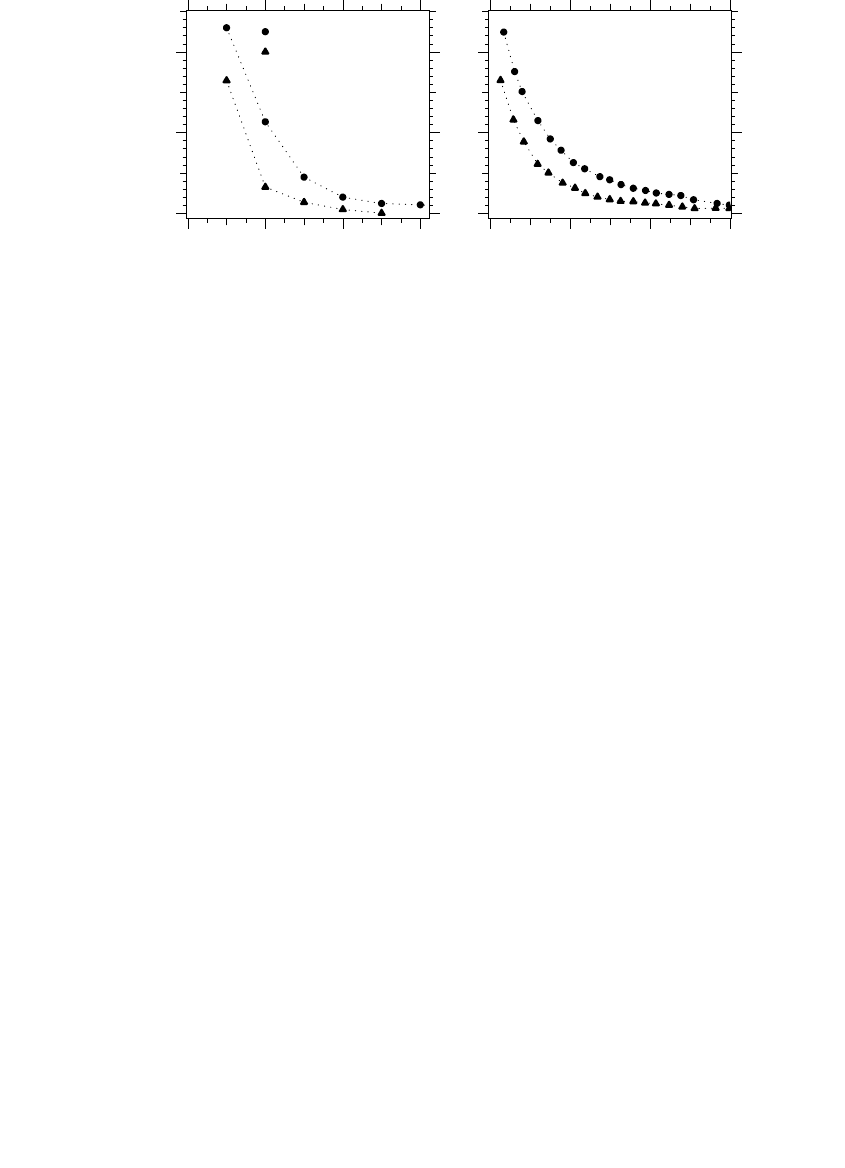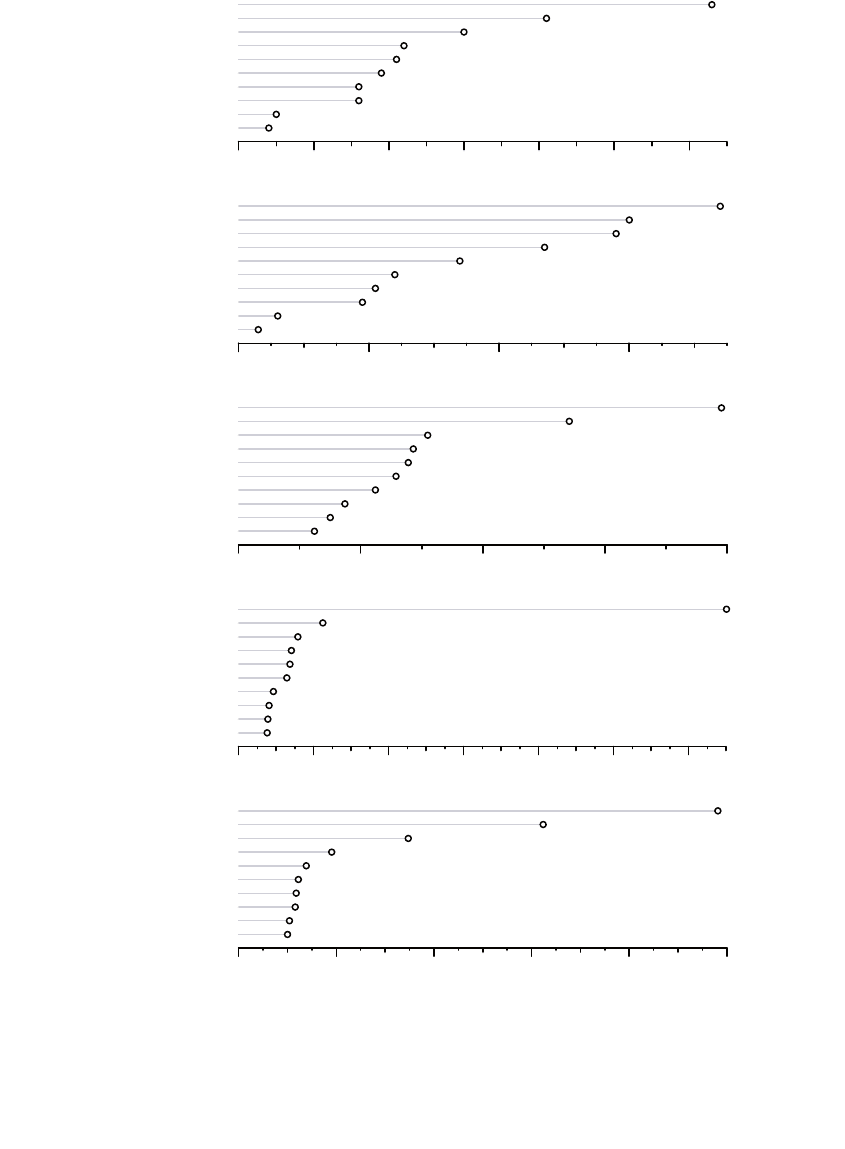Short T.A. Electric Power Distribution Handbook
Подождите немного. Документ загружается.


Reliability
457
well as fault and equipment failure rates. Fault rates are the inputs most
difficult to estimate accurately. These vary widely based on local conditions
and construction practices.
With a given circuit configuration and SAIFI and MAIFI records for the
circuit, Brown and Ochoa (1998) provide a way to back-estimate fault rates.
For a given circuit configuration, the temporary and permanent fault rates
are varied until the reliability prediction for a given circuit matches historical
records. Once the failure rates are established, we can more accurately eval-
uate circuit changes such as automated switches.
9.5 Parallel Distribution Systems
To dramatically improve reliability for customers, parallel distribution sup-
plies are needed. We see many forms of redundant distribution systems:
autolooped primary distribution circuits with redundant paths, primary or
secondary selective schemes with alternate supplies from two feeders, and
spot or grid networks of several supply feeders with secondaries tied together.
Analyzing the reliability of these interconnected systems is difficult. Several
analytical techniques are available, and some are quite complicated.
With several components in series and parallel, we can find the failure
rates and durations by reducing the network using the series or parallel
combination of elements.
Parallel elements are combined with
for
n
= 2,
The subscript
P
is the total of the parallel combination. Note that the units
must be kept the same:
l
has units of 1/years, so the repair time,
r
, must be
in units of years. Normally, this means dividing
r
by 8,760 if
r
is in hours or
525,600 if
r
is in minutes.
l
ll l
P
P
p
Pnnn
P
n
U
r
UUU U rr r
r
rr r
=
=¥¥¥=¥¥¥ ¥¥¥¥
=
+++
12 12 12
12
1
11 1
LLL
L// /
lllll
P
P
p
U
r
UU rr== + = +
12 21 121 2
()
1791_book.fm Page 457 Monday, August 4, 2003 3:20 PM
(C) 2004 by CRC Press LLC

458
Electric Power Distribution Handbook
Including parallel elements is more complicated than series elements.
The above equations are actually approximations that are valid only if the
repair time is much less than the mean time between failure. This is gen-
erally true of distribution reliability applications (and more so for high-
reliability applications).
The main problem with the equations representing the parallel combina-
tion of elements is that they are wrong for real-life electric supply reliability
with multiple sources. A good illustration of this is from the data of the
reliability of the utility supply found in a survey published in the
Gold Book
(IEEE Std. 493-1997). The average reliability of single-circuit supplies in the
Gold Book
has the following failure rate and repair time:
l
= 1.956 failures/year
r
= 79 min
If a system were supplied with two parallel sources with the above failure
rate characteristics, one would expect the following failure rates according
to the ideal equations:
l
P
= (1.956)(1.956)(79+79)/525600 = 0.00115 failures/year
r
P
= 1/(1/79 + 1/79) = 39.5 min
The actual surveyed reliability of circuits with multiple supplies is:
l
= 0.538 failures/year
r
= 22 min
Another set of data for industrial supplies is shown in Figure 9.15 for the
reliability of transmission supplies of Alberta Power. In this case, interrup-
tions were defined as taking place for longer than 1 min. As with the
Gold
Book
data, the multi-circuit Alberta Power supplies had better reliability than
single-circuit supplies, but not by orders of magnitude. Single-circuit sup-
plies had a 5-year average SAIFI of 0.9 interruptions per year (and SAIDI =
70 min of interruption/year). Multi-circuit supplies had a 5-year SAIFI of
0.42 interruptions per year (and SAIDI = 35 min of interruption/year). This
information also helps show distribution engineers the number of transmis-
sion failures.
The failure rates with multiple circuits are reduced, but they are nowhere
near the predicted value that is orders of magnitude lower. The reason the
calculations are wrong is that the equations assume that the failures are
totally independent. In reality, failures can have dependencies. The major
factors are that
1791_book.fm Page 458 Monday, August 4, 2003 3:20 PM
(C) 2004 by CRC Press LLC

Reliability
459
• Facilities share common space (utilities run two circuits on one
structure).
• Separate supplies contain a common point upstream.
• Failures bunch together during storms.
• Maintenance must be considered.
• Hidden failures can be present.
Also, parallel supplies in many cases contain endpoint equipment that is
not paralleled, including transformers, buswork, breakers, and cables.
It is possible to analytically model each of these effects. The problem is
that much of the necessary input data is unknown, so many “educated”
guesses are needed. For example, to analytically handle storm failures, one
needs to find a storm failure rate and the duration of storms (both of these
numbers are hard to come by).
It is common for multiple transmission and distribution circuits to be run
on the same structures (and to be in proximity in underground facilities). If
a car knocks down a pole with two circuits, both are lost. Lightning often
causes multiple interruptions on structures with multiple circuits. There is
also common space at the endpoint where the circuits are brought together
at the customer. If there is a fire in the basement electrical room of a building
with a spot network, the building will lose power.
Cable circuits are susceptible to a different type of outage bunching caused
by overload failures. Cables are more sensitive to thermal overloads than
are overhead lines. During high load, multiple cables can fail from overloads
at the same time (and if one cable fails, the load on the others increases to
make up the difference).
FIGURE 9.15
Comparison of single and multiple circuits for transmission supply. (Data from [Chowdhury
and Koval, 1996].)
Multiple supplies
Single supplies
0 2 4 6
0
20
40
0 200 400 600
0
20
40
SAIFI
interruptions per year
Percent of delivery points
exceeding the x-axis value
SAIDI
minutes of interruption per year
1791_book.fm Page 459 Monday, August 4, 2003 3:20 PM
(C) 2004 by CRC Press LLC

460
Electric Power Distribution Handbook
If a customer is supplied with two utility feeds off different feeders, the
common point may be the distribution substation transformer. If the trans-
former or subtransmission circuit fails, both distribution feeders are lost
simultaneously.
We can model common-mode failures of parallel supplies with the follow-
ing equations:
where
l
12
and
r
12
are the frequency and repair time of the common-mode
failures. The effect of common-mode failures is dramatic. If they are 10% of
the individual failure rates, the common-mode failures dominate and
degrade the parallel-combination failure rate.
One of the main problems is that there is little data on the common-mode
failure rate of utility circuits (especially distribution circuits; some data is
available for transmission circuits).
Failures requiring long-duration repair times are a special case with sig-
nificant impacts. If something fails and takes two months to repair or replace,
the system is much more vulnerable to failures during the maintenance.
Long-duration repairs also violate the approximation that the repair time is
much less than the MTBF, so the normal parallel and series combination
equations are in error.
Also, on systems with redundancy, human nature acts to reduce the redun-
dancy by increasing the repair time. Repairs generally take longer because
people do not feel the urgency to make the repair. If sites are without power
because of a failure, there are direct, immediate consequences. With redun-
dancy, if a failure in one component occurs, the consequences are indirect
(an increase in the likelihood of failure), so repair is not as urgent. If a
network primary cable fails, customers are not without power, so crews have
less urgency to repair the cable.
Failures due to lightning, wind, and rain occur during storms, and the
failure rate during storms is much higher than normal. Since storms are a
small portion of the total time, storm interruptions are bunched together,
which dramatically raises the possibility of overlapping outages. Billinton
and Allan (1984) provide ways to model the effects of storm bunching, and
some reliability programs model these effects.
Hidden failures
do not immediately show up or show up only when a failure
occurs. Some examples might include the following:
• If a customer is served with a primary selective scheme, but the
transfer switch is not working, the failure remains hidden until the
switch is called upon to operate.
lll l
ll l
l
P
P
P
rr
r
rr r
=++
=
+
121 2 12
1212 12 12
()
1791_book.fm Page 460 Monday, August 4, 2003 3:20 PM
(C) 2004 by CRC Press LLC

Reliability 461
•A five-feeder grid network was originally designed to be able to lose
two feeders and still serve the load. Subsequent load growth has
reduced the redundancy so that four feeders must be on-line to
handle the load. If more than one feeder is lost due to a failure and/
or maintenance, the load could have an interruption.
Hidden failures are difficult to track down. In a parallel distribution sys-
tem, the redundancy can mask failures. Protective equipment and diagnos-
tics equipment that can isolate or identify failures is especially helpful in
reducing hidden failures.
Hidden failures are difficult to model because they are obviously hidden.
Hidden failures violate the assumption that the repair time is much shorter
than the MTBF. This makes it difficult to use the equations listed above for
parallel and series connections to analyze hidden failures. Finally, data on
hidden failures is very limited.
When designing a redundant distribution system to one or more cus-
tomers, consider these strategies that help reduce the possibility of over-
lapping failures:
• Common space — Limit sharing of physical space as much as possible.
For services with multiple sources — primary or secondary selective
schemes — try to use circuits that do not share the same poles or
even right of ways. Use circuits that originate out of different dis-
tribution substations.
• Storms — Using underground equipment helps reduce the possibil-
ity of overlapping storm outages (although cables have their own
bunched failures from overloads).
• Maintenance — Coordinate maintenance as much as possible to limit
the loss of redundancy during maintenance. Try to avoid mainte-
nance during stormy weather including heat waves for cables.
• Testing — Test switches, protective devices, and other equipment
where hidden failures may lurk.
• Loadings — Review loadings periodically to ensure that overloads
are not reducing designed redundancy.
9.6 Improving Reliability
We have many different methods of reducing long-duration interruptions
including
• Reduce faults — tree trimming, tree wire, animal guards, arresters,
circuit patrols
1791_book.fm Page 461 Monday, August 4, 2003 3:20 PM
(C) 2004 by CRC Press LLC

462 Electric Power Distribution Handbook
• Find and repair faults faster — faulted circuit indicators, outage man-
agement system, crew staffing, better cable fault finding
• Limit the number of customers interrupted — more fuses, reclosers,
sectionalizers
• Only interrupt customers for permanent faults — reclosers instead of
fuses, fuse saving schemes
Whether we are trying to improve the reliability on one particular circuit
or trying to raise the reliability system wide, the main steps are
1. Identify possible projects.
2. Estimate the cost of each configuration or option.
3. Estimate the improvement in reliability with each option.
4. Rank the projects based on a cost-benefit ratio.
Prediction of costs is generally straightforward; predicting improvement
is not. Some projects are difficult to attach a number to.
An important step in improving reliability is defining what measure to
optimize: is it SAIFI, SAIDI, some combination, or something else entirely?
The ranked projects change with the goal. Surveys have shown that fre-
quency of interruptions is most important to customers (until you get to
very long interruptions). Regulators tend to favor duration indicators since
they are more of an indicator of utility responsiveness, and excessive cost
cutting might first appear as a longer response time to interruptions.
Detailed analysis and ranking of projects can be done on a large scale.
Brown et. al. (2001) provide an interesting example of applying reliability
modeling to Commonwealth Edison’s entire distribution system in Illinois
to rank configuration improvements. Normally, large-scale projects require
simplification (and often a good bit of guesswork).
Adding reclosers, putting in more fusing points, automating switches —
these configuration changes are predictable. Many computer programs will
quantify these improvements. Projects aimed at reducing the rates of faults,
such as trimming more trees, adding more arresters, installing squirrel
guards, are difficult to quantify. Improving fault-finding and repair are also
more difficult to quantify. A sensitivity analysis helps when deciding on these
projects. In the simplest form, rather than using one performance number,
use a low, a best guess, and a high estimate. Pinpointing fault causes also
helps frame how much benefit these targeted solutions can have (if there are
few lightning-caused faults, additional arresters will provide little benefit).
9.6.1 Identify and Target Fault Causes
Tracking and targeting fault types helps identify where to focus improve-
ments. If animals are not causing faults, we do not need animal guards.
1791_book.fm Page 462 Monday, August 4, 2003 3:20 PM
(C) 2004 by CRC Press LLC

Reliability 463
Many utilities tag interruptions with identifying codes. The system-wide
database of fault identifications is a treasure of information that we can use
to help improve future reliability.
Different fault causes affect different reliability indices. Figure 9.16 shows
the impact of several interruption causes on different reliability parameters
for Canadian utilities. Relative impacts vary widely; for example, trees had
a high repair time but impacted fewer customers.
Tracking this type of data for a utility operating region helps identify the
most common problems for that service area. These numbers change by
region depending on weather, construction practices, load densities, and
other factors.
9.6.2 Identify and Target Circuits
Do not treat all circuits the same. The most important sections are usually
not the locations with the most faults per mile. The number of customers on
a circuit and the type of customers on a circuit are important considerations.
For example, a suburban circuit with many high-tech commercial customers
should warrant different treatment than a rural circuit with fewer, mostly
residential and agricultural customers. How this is weighted depends on the
utility’s philosophy.
On radial distribution circuits, the three-phase mainline is critical. Sus-
tained interruptions on the mains locks out all customers on the circuit until
crews repair the damage. Feeders with extra-long mainlines have more inter-
ruptions. To reduce the impact of mainline exposure, trim trees more often
on the mains and patrol the mains more often. Mainline sectionalizing
switches help by allowing quick restoration of customers upstream of the
fault; automated switches are even better. Another improvement is using
normally open tie switches to other feeders, enabling crews to move load to
other feeders during sectionalizing.
Lateral taps are another target. We can rank these by historical perfor-
mance, taking into account their length and number of customers. Some
longer laterals are good candidates for single-phase reclosers instead of fuses.
9.6.3 Switching and Protection Equipment
Fuses, sectionalizing switches, reclosers, sectionalizers — more, more, more
— the more we have, the more we isolate faults to smaller chunks of circuitry,
the fewer customers we interrupt.
Taps are almost universally fused, primarily for reliability. Fuses make
cheap fault finders. Planners should also try to design to have tap exposure,
not too much and not too little. We want to have a high percentage of a
circuit’s exposure on fused taps, so when permanent faults occur on those
sections, only a small number of customers are interrupted.
1791_book.fm Page 463 Monday, August 4, 2003 3:20 PM
(C) 2004 by CRC Press LLC

464 Electric Power Distribution Handbook
FIGURE 9.16
Root-cause contributors to different reliability parameters. (Data from [CEA, 2001].)
Adverse environment
Human element
Lightning
Foreign interference
Adverse weather
Unknown/Other
Tree contact
Scheduled outages
Defective equipment
Loss of supply
0.0 0.1 0.2 0.3 0.4 0.5 0.6
SAIFI, annual interruptions per customer
0.0 0.1 0.2 0.3 0.4 0.5 0.6
Human element
Adverse environment
Unknown/Other
Foreign interference
Lightning
Scheduled outages
Loss of supply
Defective equipment
Tree contact
Adverse weather
0.0 0.2 0.4 0.6
SAIDI, annual interruptionhours per customer
0.0 0.2 0.4 0.6
Human element
Loss of supply
Unknown/Other
Scheduled outages
Foreign interference
Defective equipment
Adverse environment
Lightning
Tree contact
Adverse weather
01234
CAIDI, average hours per interruption
01234
Lightning
Foreign interference
Adverse environment
Scheduled outages
Tree contact
Defective equipment
Unknown/Other
Adverse weather
Human element
Loss of supply
0 200 400 600 800 1000 1200
Average number of customers per interruption
0 200 400 600 800 1000 1200
Foreign interference
Scheduled outages
Adverse environment
Lightning
Unknown/Other
Human element
Defective equipment
Tree contact
Adverse weather
Loss of supply
0 200 400 600 800 1000
Average customer-hours per interruption
0 200 400 600 800 1000
1791_book.fm Page 464 Monday, August 4, 2003 3:20 PM
(C) 2004 by CRC Press LLC

Reliability 465
If taps become too long, use reclosers instead of fuses. Especially for
circuits that fan out into two or three main sections (really like having two
or three mainlines), reclosers on each of the main sections help improve
reliability.
How circuits are protected and coordinated impacts reliability (see Chapter
8). Fuse saving, where the station breaker trips before tap fuses to try to clear
temporary faults, helps long-duration interruptions most (but causes more
momentary interruptions). Fuse blowing causes more long-duration inter-
ruptions because the fuse always blows, even for temporary faults.
Mainline reclosers also help improve reliability. Table 9.4 compares differ-
ent scenarios for a common feeder with the following assumptions: 5-mi
mains, 15 total mi of exposure, 0.3 permanent faults/mi/year, 0.6 temporary
faults/mi/year, fused laterals average 0.5 mi, and customers are evenly
distributed along the main line and taps. Mainline faults contribute most to
SAIFI (1.5 interruptions per year). If the system were not fused at all, it would
have 4.5 interruptions per year, pointing out the great benefit of the fuses.
Branch-line faults only contribute an average of 0.15 interruptions with fuse
saving (assuming fuse saving works right). This is an average; some cus-
tomers on long taps have many more interruptions due to branch-line faults
(these are good candidates for reclosers instead of fuses). On a purely radial
system, reclosers do not help customers at the end of the line. An auto-loop
scheme helps the customers at the ends of the line and significantly improves
the feeder reliability indices.
This example only includes distribution primary interruptions. Supply-
side interruptions and secondary interruptions should also be added as
appropriate.
Sectionalizing switches can significantly improve SAIDI and CAIDI (but
not SAIFI, unless the switches are automated). Such switches enable crews
to easily reenergize significant numbers of customers well before they fix
the actual damage. As Brown’s analysis (2002) shows, the biggest gains are
with the first few switches. Both SAIDI and CAIDI for mainline faults reduce
in proportion to the difference between the mean time to repair (t
repair
) and
the mean time to switch (t
switch
). With evenly spaced switches and customers
TABLE 9.4
Example Reliability Improvement Calculations
SAIFI MAIFI
Base case, fuse saving 5(0.3)+0.5(0.3) = 1.65 5(0.5)+10(0.9) = 12
Base case, fuse blowing 5(0.3)+0.5(0.9) = 1.95 5(0.6) = 3
One recloser, fuse blowing (1.95+1.95/2)/2 = 1.46 (3+3/2)/2 = 2.25
Three-recloser auto-loop, fuse blowing 1.95/2 = 0.98 (3+3/2)/2 = 2.25
Five-recloser auto-loop, fuse blowing 1.95/3 = 0.65 (3+2+1)/3 = 2
Note: 5-mi mains, 15 total mi of exposure, 0.3 permanent faults/mi/year, 0.6 temporary
faults/mi/year, fused laterals average 0.5 mi, customers are evenly distributed
along the mainline and taps.
1791_book.fm Page 465 Monday, August 4, 2003 3:20 PM
(C) 2004 by CRC Press LLC

466 Electric Power Distribution Handbook
on a radial circuit with no backfeeds, both CAIDI and SAIDI reduce with
increasing numbers of sectionalizing switches as
where
R = reduction in CAIDI and SAIDI
n = number of sectionalizing switches on the mainline
t
repair
= time to repair the damage
t
switch
= time to operate the sectionalizing switch
On a radial circuit, the improvement is not distributed equally; switches
do not help customers at the end of the line at all. If a circuit has two evenly
spaced sectionalizing circuits, the customers on the last part of the circuit
see no improvement, the middle third see improvement for faults on the last
third of the circuit, and the third at the front see improvement for faults on
the last two-thirds of the circuit.
If the circuit has a backfeed from another circuit, the improvement is equal
for all customers, so the overall circuit CAIDI improves. For evenly spaced
switches and customers, the reduction is
Figure 9.17 shows how much sectionalizing switches can reduce CAIDI
and SAIDI for the portion due to faults on the main line. The first switches
provide the biggest bang for the buck. Beyond five switches, improvement
is marginal. For application on real feeders (where the loads are not evenly
placed), for biggest gains on radial circuits, place switches just downstream
of large blocks of customers. If a circuit has a branch line with many cus-
tomers, a mainline sectionalizing switch just downstream of the tap point
allows crews to sectionalize that big block of customers for faults down-
stream of the switch.
The mean time to switch (t
switch
) includes the time for the crew to get to
the circuit, the time they need to find the fault, the time to find and open
the appropriate sectionalizing switch, and finally the time to close the tripped
breaker or recloser. Typically, t
switch
is about 1 h. The mean time to repair
(t
repair
) is the time to travel to the circuit, find the fault, repair the damage,
and close in the appropriate switching device to reconnect customers. The
repair time varies widely — 4 h is a good estimate; actual repairs regularly
range from 2 to 8 h.
Crews should decide whether to sectionalize based on local conditions.
What is damaged? How long will it take to fix? How many customers would
R
i
n
tt
i
n
repair
switch
=
+
-
=
Â
1
2
1()
()
R
n
n
tt
repair
switch
=
+
-
1
()
1791_book.fm Page 466 Monday, August 4, 2003 3:20 PM
(C) 2004 by CRC Press LLC
